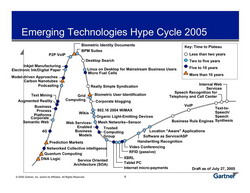Since bursting onto the public scene one year ago today at an impressive (yet in hindsight conservative) market valuation of $23 billion, and a corresponding stock price of $85, Google has been busy innovating. It’s launched at least a dozen new products since its IPO.
In its first year as a public company, Google managed to capture investor attention by repeatedly topping their earnings expectations, and by constant innovation, a thing expected, given that Google’s corporate culture and organizational principles include dedicating 20% of work time toward musing, exploring, and quite simply — creating.

Exactly one year after their initial IPO Google announced that it has filed a registration statement with the Securities and Exchange Commission for a proposed public offering by the company of 14,159,265 (yeah those are the decimals in PI) shares of Class A common stock.
Decided to pick-up the glove Microsoft (with its search.msn.com or new buzz around its new IE7.0) and Yahoo! (with recent launch of AdSense‘s competitor, Yahoo!Publisher Network) is launching a new products campaign.
Google just released Google Desktop Search 2, which includes a new piece of software that could challenge both Microsoft and Yahoo, on various levels. The free program, known as Sidebar, presents consumers with a pane of customized information — such as weather forecasts, stock quotes, news headlines, text feeds from favorite Web sites, photo slideshows and email alerts — that sits alongside whatever else the user is viewing. It provides some functions similar to Yahoo’s popular MyYahoo customized Web-page service.
In other words, as analysts put it:
“I guess the plan is to demote browser to ‘rendering engine,’ and combine all its other functions into “desktop search,” er, that is, ‘Google Desktop.'”
If Google really does turn IE into little more than a rendering engine, Microsoft will only have itself to blame. Wasn’t the whole justification for making the browser part of Windows to make the rendering engine a platform, so that developers could make it part of their applications? Looks like Google is doing exactly that.
Well it seems that Google Sidebar not only put pressure on Microsoft, but Yahoo as well.
If Google gets traction with Sidebar, users will find that it’s a more convenient way of accessing weather info, news, stock quotes and photos, as well as email, than going to Yahoo.com (which is the biggest content provider at the moment) and finding the appropriate links.
What’s missing?
Google needs to add instant messaging and probably personal web publishing to the tool”, Internet Stock blog says.
The New York Times said in an article couple of days ago
Google executives say they plan to unveil on Wednesday a “communications tool” that is potentially a clear step beyond the company’s search-related business focus.
While executives would not disclose what the new software tool might be, Google has long been expected to introduce an instant messaging service to compete with services offered by America Online, Yahoo and MSN from Microsoft.
It’s even more than that.
There’s a host responding at talk.google.com and is actually redirecting to http://www.google.com/talk.
Tom Servo, tried to connect to talk.google.com using his Trillian client. What he got was a secure XMPP (Extensible Messaging and Presence Protocol, alternatively known as Jabber) server waiting for connections. And according to this post, Jabber server listening on port 5222 of ‘talk.google.com’.
Well, while waiting for new developments here are some of theGoogle’s new products launched in the year passed frot its IPO:
October 2004
- Google bought Keyhole, which delivers a multi terabyte database of images and mapping information that let’s users “fly around the world from their home computer.”
- Google announced Desktop search
- Launched its SMS product, enabling people to get information instantly on their mobile handsets,
- introduced Google Print, which lets people read excerpts of book content.
November 2004
- Google launches Google Scholar a service that search through journal articles, abstracts and other scholarly literature
December 2004
- the company announced its offer to the world’s premier libraries to digitize their collections and make them searchable on the Web
- Google suggest is launched
January 2005
- With Google Video, users can search the content of TV programs, such as PBS, the NBA, Fox News and C-Span.
February 2005
March 2005
- Google rolled out enhancements to Google News, making it possible for users to customize the service to fit their needs.
- Google Maps was integrated with Google Local products and then Keyhole, for satellite imagery.
- Google upped the storage it offered for Gmail users to 2 GB, and it is still growing today
April 2005
- Google began to offer users the ability to upload video to Google with the aim of allowing them to distribute and monetize that video.
- Google launched My Search History, a service that let’s people find their past searches.
May 2005
June 2005
- a free enhanced version of Keyhole was offered, and it became known as Google Earth
You can see all new Google products (including the ones in beta stage) at Google Labs.
Technorati tags: Google, Google Desktop Seach, Google Sidebar, Google IM


